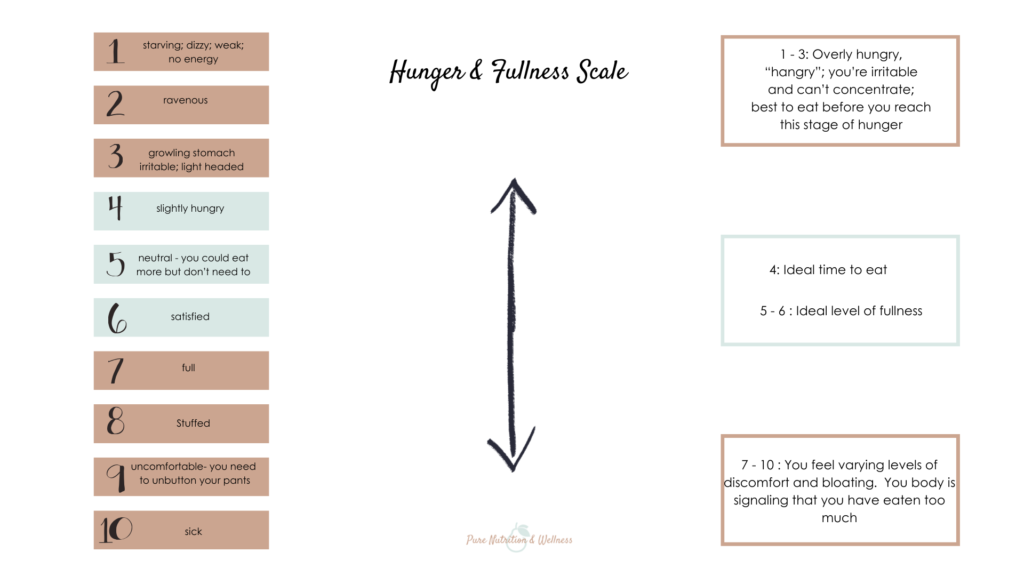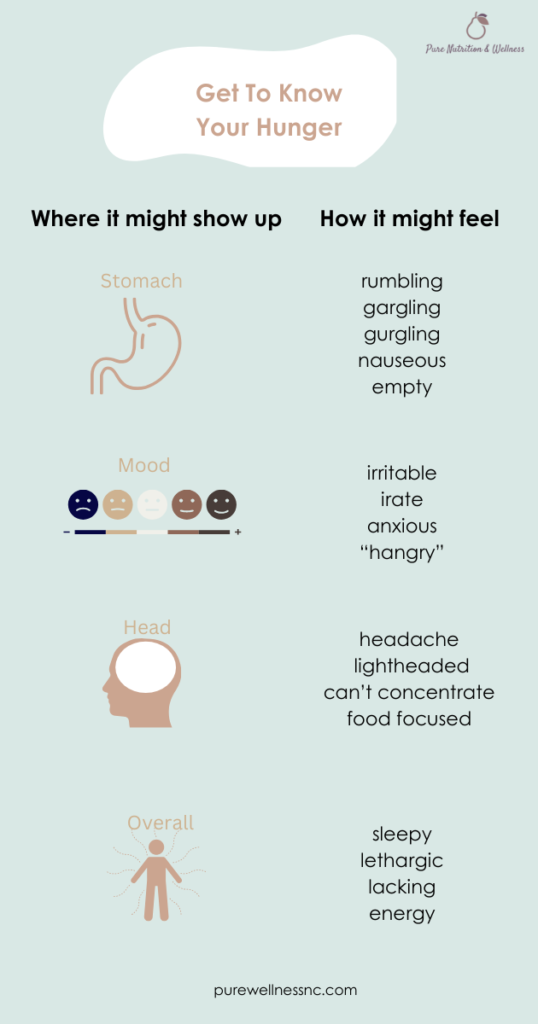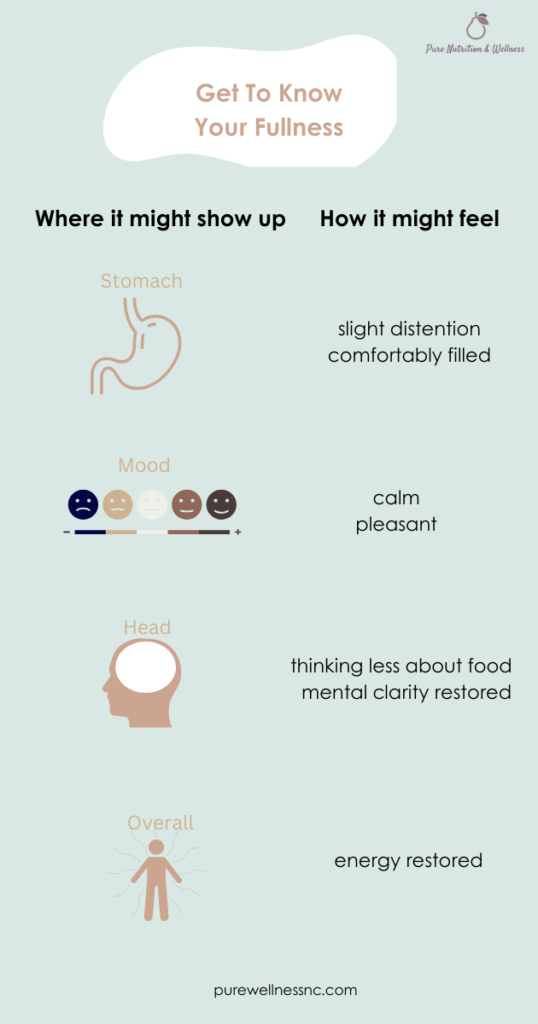Weight loss is a complex process, and our relationship to food is one aspect that is often overlooked. Successful weight management is more than just eating the “right” foods or the correct portions. It’s also about why you eat. If you have a habit of overeating or routinely eating outside of true hunger, managing weight (unsurprisingly) becomes more challenging, and one solution to chronic overeating is to begin reacquainting yourself with your body’s internal hunger and satiety cues. Listening and responding to hunger cues is a skill that we were all born with, yet overtime and for a variety of reasons, we stop using that innate skill. While using hunger and satiety cues (eating when you start to feel hunger and stopping before you are overly full) to dictate your eating behavior might feel unattainable, it is possible for anyone willing to put in the effort to reacquaint yourself with your own internal cues; we can all re-learn how to use internal cues so that we eat when we’re beginning to feel hungry and stop when we’ve had just enough.
Understanding Hunger and Satiety Cues
Our bodies have an innate language that is used to communicate our need for nourishment. This conversation takes place between our digestive system and brain via hunger and satiety cues and is facilitated by a complex chemical cocktail of hormones and neurotransmitters. These cues manifest as sensations of hunger or fullness that help regulate our food intake. However, these signals can often be overshadowed or misinterpreted due to stress, tough emotions, chronic dieting, or even multitasking while we eat. This can disrupt our eating habits and lead to over or under-eating. Gaining a clear understanding of the specific ways these cues show up for you is a pivotal step toward fostering a healthier relationship with food and getting out of the cycle of mindless overeating. This awareness is not only crucial for keeping our bodies adequately nourished but also plays a significant role in weight management. One thing I’ve noticed while working with clients is that most people don’t lack knowledge about what to eat or even how much to eat- most of us have a general idea of what “healthy” eating looks like. But we tend to lack awareness of why we are eating- we eat in autopilot, often for reasons other than biological hunger and this habit leads to chronic overeating because we aren’t tuning into our body’s hunger and fullness signals; we’re just letting the overeating happen to us. Often, overeating is followed by feelings of guilt or shame leading us to vow to do better and restrict certain foods that we deem “bad”. Restriction then triggers overeating and this cycle of binging and restricting continues. This binge and restrict cycle is super common in people who diet. But, by learning to listen to your hunger and satiety cues and practicing mindful eating, you’re more equipped to make informed decisions about what, when, and how much to eat. Ultimately, this understanding supports you in your journey towards sustainable weight loss and overall wellness.
Distinguishing Between Physical and Emotional Hunger
Understanding the nuances between physical and emotional hunger is integral to successful weight management, and learning to interpret your body’s hunger cues is one important step in differentiating between physical and emotional hunger. I’m not shaming emotional eating here- emotional eating is normal and it’s not a problem unless it’s a problem for you. In other words, if emotional or mindless eating is preventing you from reaching health goals or feels out-of-control to you, then learning skills to end emotional eating is an important part of your health journey, and a fantastic starting point is simply learning to identify what physical hunger and satiety feels like to you.
Physical hunger is the body’s biological need for nourishment that arises slowly and can be appeased by any type of food. As you become physically hungry, your body sends cues to tell you to eat. These cues come from a complex neurochemical and hormonal interplay. It’s primal and we all experience hunger and satiety cues, although for a variety of reasons, the cues may be blurred and difficult to interpret.
On the other hand, emotional hunger surfaces rapidly and is often linked to specific cravings. It’s a reaction to various emotions like stress, boredom, or even happiness rather than an actual need for physical nourishment. When you’re driven by emotional hunger, you might find yourself reaching out for your favorite comfort foods. Often emotionally driven urges to eat trigger consumption of highly processed food and foods that are high in sugar, fat or salt. Unlike physical hunger, emotional hunger is not satisfied by just any food, but instead you’re hungry for that specific something that will make you feel better.
The key to differentiating between these two types of hunger lies in their characteristics.
Characteristics of Physical Hunger
-comes on gradually
-often felt in your stomach
-not focused on one type of food (most any food will do)
-satisfied with an appropriate portion
-rarely associated with guilt
-often felt 3 to 4 hours after eating a balanced, well-portioned meal
Characteristics of Emotional Hunger
-Manifests suddenly and intensely
-In your thoughts and mind
-Centered around a particular type of food
-Feels insatiable so you don’t stop until you’ve already overeaten
-Leaves you feeling guilty or ashamed before, during and/or after eating
-Occurs independent of the last time you ate
Recognizing this distinction can empower you to get a grip on emotional eating, which is often a hurdle in weight loss and other health goals. By understanding the nature of your hunger, you can bring awareness into your eating and make more mindful food choices, leading to healthier eating patterns and effective weight management.
The Hunger Scale: A Tool For Success
The hunger scale is a helpful tool you can utilize to improve your ability to perceive and respond to your body’s hunger and fullness signals. The hunger scale is a rating scale from 1, representing extreme hunger, to 10, denoting an uncomfortable level of fullness. To use the hunger scale, you simply pause before and throughout your eating experience to rate where you are on the scale of 1 to 10. A healthy practice is to initiate eating when you’re at approximately level 4, which signifies the onset of hunger, and conclude your meal when you reach a 6, which is a state of comfortable satisfaction, a point where you could eat more, but don’t need to to feel satisfied. This practice encourages you to eat when you’re genuinely hungry and stop before you’re overly full, thus reducing overeating and under-eating. Using the hunger scale works because it brings mindfulness back into the eating process. Often, we allow external cues to tell us when and how much to eat- we eat based on the time of day or because there are free donuts in the break room. But with use of the hunger scale, we create a pause before we eat to really consider if we’re actually hungry. We take time to check in with our body and bring awareness to what our body needs in the moment. A lack of physical hunger doesn’t mean you can’t eat, it just means that you bring the choice of whether or not to eat into your conscious awareness. You pay attention to how your body feels.
Regular use of the hunger scale can enhance your attunement to your body’s unique cues of hunger and satiety. This heightened awareness can foster more conscious eating patterns which contribute to effective weight management, and, by using this tool, you may also become more adept at distinguishing between physical and emotional hunger. Using the hunger scale and getting in tune with your body’s hunger and satiety cues doesn’t prevent emotional eating, but it certainly gives you a head start on understanding your eating triggers and habits.
How To Use The Hunger Scale

Using the hunger scale involves a practice of becoming interoceptive, pausing to pay attention to your internal state and deciding where you fall on the hunger scale. It’s based on your own perception so you can’t do it wrong. The more you practice identifying your hunger and fullness, the more familiar you’ll become with how each level feels like for you. This could look like pausing at various times throughout the day to check in with your body and notice your hunger level. If you find you are at a level 4, that’s a great time to either grab a snack to tide you over until your next meal or a start eating a meal. You can use this rating scale multiple times throughout the meal, continuously tuning into your internal environment. When you find you’re at a 6, that’s a great time to stop eating, even if you have food left on your plate. Remember, there’s no prize for cleaning your plate and if you don’t finish all your food, you can always go back to it later if you become hungry. You can’t undo what you’ve already eaten though, and once you’ve beyond comfortable fullness not only do you have to deal with the discomfort but also you’ve probably taken in more calories than you body needs, which is obviously not conducive to weight loss or weight maintenance. Practice leaving food on your plate as a means to start noticing satiety. Intentionally pause with a few bites left and assess your hunger and satiety, just wait for a few minutes before you decide if you want to continue eating. It may take up to 20 minutes for you to register that you are full, so consider pausing with a few bites left, cleaning up your cookware or other dishes and then come back to your plate. Then tune in to your body’s cues and decide if you want to finish eating or not. This practice helps you become more aware of the feeling of satiety or comfortable fullness.
The more you use the hunger scale, the easier it becomes to recognize your hunger and fullness. You’ll start to notice specific sensations that indicate a level 2, or 5 or 8, etc. Becoming aware of your true hunger and satiety helps you combat all the extra calories you take in from mindless eating and is a step in the right direction for managing emotional eating.
Physical Signs of Hunger and Fullness
The physical manifestation of hunger and fullness feels different to everyone. Some might experience the onset of hunger with a feeling of weakness or lethargy, a slight headache, difficulty concentrating, constant thoughts of food, a rumbling in their belly, a feeling of emptiness in their belly, irritability or lightheadedness, and different degrees of hunger will trigger different physical sensations. Satiation could feel like slight distention in your belly, you find your thoughts are not as food-focused as when you began eating, your energy levels may feel restored and your overall mood is calm.


Remember, this is a subjective scale- what feels like a 4 for you is not necessarily what a 4 feels like for someone else. It’s based on your own perception so you can’t get it wrong. The more you practice the more familiar you’ll become with what each level feels like for you. A great goal is to start eating when you notice you are at a 4 and stop eating at a 6. This prevents you from becoming overly hungry (which often triggers overeating) or experiencing uncomfortable fullness and consuming excess calories.
Using the hunger scale comes with challenges. Many of us don’t have the luxury of always being able to eat as soon as we begin feeling hungry- we might have a demanding job that prevents us from eating at the onset of hunger or we might have other commitments that get in the way. That’s ok. This process doesn’t have to be perfect. Do the best you can. Eat at a 4 when you’re able. Practice stopping at a 6. This is about learning to listen to your body and honoring your hunger and fullness as best you can most of the time.
The hunger scale is not a rigid rule to be strictly followed but rather a helpful guide to assist you in making more mindful decisions about when to start and stop eating. This is a long-term practice, not a quick fix. It might take some time to get accustomed to interpreting your hunger and fullness cues, but with patience and consistency, you’ll gain a better understanding of your body’s needs and develop healthier eating habits that support your wellness journey.
Rebuilding Trust With Your Body
Regaining the skill of interpreting your body’s natural signals is a crucial step in promoting a healthy relationship with food. With our busy lifestyles and history of disregarding our hunger cues, it’s easy to lose touch with these inherent signals. However, this connection can be rekindled. The fact that we all once ate based on our hunger and satiety cues (think about how a baby cries for food when they are hungry and rejects the bottle or breast when they’ve had enough) means that you can relearn how to interpret those innately wired cues. Start by being more mindful during meal times. Instead of eating on autopilot or while distracted, take the time to savor each bite. Focus on the flavors, the textures, and the scent of your food. This mindfulness practice can help you fully appreciate your meal and increase your awareness of your body’s signals, thus promoting better attunement to your feelings of hunger and fullness.
Avoid engaging in other activities while you eat, like scrolling social media or watching tv. These activities promote mindless eating and will keep you distracted from hearing your internal hunger and satiety cues.
Create a habit of checking in with your body at various times throughout your meal and determine where you are on the hunger scale. It takes time for your brain to register fullness, so consider stopping before you feel full. It’s ok to leave food on your plate. You can always go back to eat it later, or you can save it for another meal.
Be patient with yourself during this process. Relearning to trust your body’s cues is a journey that may take time. You might have days that you second-guess your hunger or fullness signals, and that’s okay. You might feel like you have no idea what hunger feels like. That’s ok too. In fact, it’s very common, especially if you have a history or dieting or have a busy lifestyle. The goal isn’t to achieve perfection but to progressively strengthen your ability to interpret your body’s cues and react to them accordingly.
And, please remember to treat your body with kindness and respect. It’s easy to feel frustrated if you’re not immediately in sync with your body’s signals. Your body is not the enemy; it is a faithful ally in your quest for wellness and weight management. Listening to it and honoring its needs can pave the way to a healthier relationship with food and a more successful health journey.
Seeking Professional Guidance
When it comes to navigating your hunger and satiety cues, enlisting the expertise of a dietitian who can guide you through the use of tools like the hunger scale and provide practical advice on implementing balanced, regular meals into your routine can be a game changer. With extensive knowledge of food and its effect on our bodies, experts can help you decode your body’s cues and offer strategies to manage emotional eating or unhealthy habits that might be affecting your relationship with food. You can book a free consultation with Pure Nutrition and Wellness here.
Remember, it’s okay to seek help. Building a healthier relationship with food is a significant undertaking, and doing so with the guidance of a professional can make the journey more manageable and less overwhelming. In this path toward wellness and effective weight loss, a dietitian can be a valuable ally, illuminating the way to better understand and respect your body’s internal hunger and satiety cues. Learn more about how a dietitian can make a difference in your health journey.
